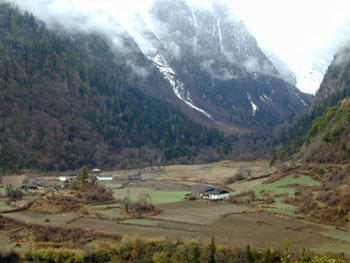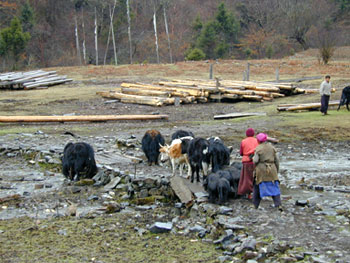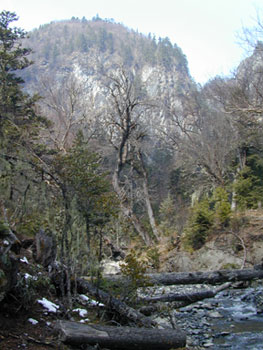A Village Near the Sky
Greater Tibet (Yunnan, China), 2002
Part 1 of 3
Go to: Part 1 - Part 2 - Part 3
[Full story also available as a PDF download]
“Tibetans don’t like the earth, they like the sky.” Ahqing means no disrespect to the environment around him. He is closely attuned to the many ways that the land sustains his village of Yubeng. But when he seeks escape from the cares of life, he climbs into the mountains. The heights revive his spirit.
Ahqing lives in an ideal place for his sentiment. Meili Snow Mountain towers four miles high, guarding the community of  150 souls split between upper and lower villages. Pilgrims flock here to pray beneath its summit Kawagebo, one of the holiest peaks of Tibetan Buddhism. Ahqing can walk out his door and up a valley leading to its slopes to worship at sacred caves and waterfalls. He truly lives near the sky.
150 souls split between upper and lower villages. Pilgrims flock here to pray beneath its summit Kawagebo, one of the holiest peaks of Tibetan Buddhism. Ahqing can walk out his door and up a valley leading to its slopes to worship at sacred caves and waterfalls. He truly lives near the sky.
But life is a daily struggle at 10,000 feet. Ahqing plows his fields in the spring, preparing them for wheat or potatoes. While the crops are growing, he and his brother carry axes into the woods to cut timber. The women of the household tend to chickens and ducks. Later in the year, the forest yields mushrooms and medicinal plants, which he can sell for desperately-needed cash. Everyone in the family pitches in at the guest house that he built a couple of years back.
Sitting on the veranda of the guest house, I watch the rhythms of the village that sits in far northwest Yunnan. Tibet, that is the official boundary of the Tibetan Autonomous Republic, begins on the other side of the mountain. I am already far into Greater Tibet, the broader region into which the lamas and the people carried their culture and their Buddhism centuries before. A five-hour walk led me here with my wife Diane and our friend Justin. We are three early tourists who represent the future of the village, or the threat, depending on the perspective.
 A woman sits beside me. Her wrinkled skin and toothless mouth show her age. A purple knit cap covers her head. Layers of soiled clothing warm her from the wind blowing off the slopes of Meili on a cold March day. Her right hand grips the handle of a prayer wheel, kept spinning by the flick of her wrist. The fingers on her left click rosary beads. She wonders if the pictures I show her in a book are of relatives.
A woman sits beside me. Her wrinkled skin and toothless mouth show her age. A purple knit cap covers her head. Layers of soiled clothing warm her from the wind blowing off the slopes of Meili on a cold March day. Her right hand grips the handle of a prayer wheel, kept spinning by the flick of her wrist. The fingers on her left click rosary beads. She wonders if the pictures I show her in a book are of relatives.
A shrine stands outside the courtyard, piled high with slate slabs engraved in ancient script. The path around it is the village’s major thoroughfare. Each morning, animals parade by heading for the valley to graze – horses, donkeys, yaks, cows, pigs, ducks. Women and children haul jugs to the river for water. Men drive animals that have lagged behind or carry various implements for squaring or sawing the trees they have felled. The approach of dusk signals the animals and the men to wander back. Even the donkeys and yaks know always to veer left around the stones, coming or going.
A grandfather pauses at the gate with a young girl. He looks like the village radical, with his long hair pulled through a ring and piled under a broad-brimmed felt hat, sunglasses hiding his eyes, a scraggly beard on his chin. He lifts his granddaughter to stare at the visitors. We holler, “Ni Hou,” the Chinese greeting that literally translates as “You Good?” After several minutes, the pair continues over a bridge spanning a shallow stream that parallels the main river below our sight. They circle the pagoda on the opposite bank, each time around attesting to their faith. We expect three revolutions, then nine, maybe 13. An hour later, the man is still pushing the girl round and round.
“He is 68,” a younger man who has stopped into the courtyard tells us. “The old people grow more devout with age. They are closer to death.” The girl is surely picking up her grandfather’s spirituality, whether by his design or simply because her mother instructed the old man to get her daughter out of the house.
The pagoda is recently reconstructed, along with a monastery in the upper village. The Red Guards destroyed both during the Cultural Revolution as they tried to stamp out the religions they regarded as nothing more than dangerous superstitions. With the changing times, the provincial government has contributed to rebuilding the stupa, a square white base with terraces tiering up to an inverted cone, itself topped with a thin red pyramid 30 feet above the ground. A dozen flags wave white, yellow, red and blue, adding color to the landscape. The poles fit ingeniously into wooden bases, a feature that allows the shafts to be unpegged and lowered to the ground for the changing of the flags. Each flap in the wind contributes a prayer to build merit for the village. A short wooden shed houses a prayer wheel by the stream. Water spills from a flume to hit the paddles underneath, turning it continually. Each spin offers another prayer.
“I don’t want a road or a gondola,” says Ana Zhu, in whose home in the upper village we stayed our first evening. He is relating the controversy over how to link Yubeng with the outside world. “A road will make it easy for poachers to steal our resources.” As forest  manager, he administers programs to protect the environment, and the community’s livelihood that stems from it. He enforces the logging restrictions, which limit the harvest to local uses, and manages the applications to cut that must pass up the chain to the township, then the county, for approval. His stewardship extends to policing activities and levying fines on violators.
manager, he administers programs to protect the environment, and the community’s livelihood that stems from it. He enforces the logging restrictions, which limit the harvest to local uses, and manages the applications to cut that must pass up the chain to the township, then the county, for approval. His stewardship extends to policing activities and levying fines on violators.
“A gondola will bring hordes of tourists. They will ride up for a few hours. Each one will pick an orchid or some other plant. One won’t matter but together they will devastate the forest. And they will spend no money.” The experience with the lift on Jade Dragon Snow Mountain a few hundred kilometers to the south lends credence to his claim. Chinese tourists arrive by the busload, ride to the top and trample the tundra as they snap photos of themselves with the mountain as a backdrop. Then the buses drive an hour to Lijiang for an afternoon of shopping in the city.
Ahqing, the Tibetan who loves the sky, also hopes that the village will not end its relative isolation. He dreams of the day when wildlife revives to the spectacle that populated the valley before 1949, when the communists brought Liberation. In those days, two landlords owned everything. A marker downstream identified the boundary below which they permitted the villagers to hunt. Above was preserved as a sanctuary. The revolution brought division of the land and hunting throughout the area. By 1987, the government recognized how the animal population was collapsing and banned further killing.
“A road threatens the recovery,” Ahqing worries. “Poachers already come up from the Mekong to shoot deer, bear and wild cows. People will buy the organs and intestines of a deer for medicine. The horns, hide, bones and meat of the cows are all sold in the market.”
Go to: Part 2
Bill's Books
A Novel of New Amsterdam
The Mevrouw Who Saved Manhattan
"[A] romp through the history of New Netherland that would surely have Petrus Stuyvesant complaining about the riot transpiring between its pages."
- de Halve Maen, Journal of the Holland Society of New York

